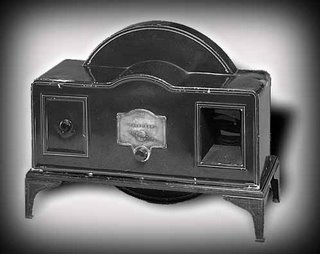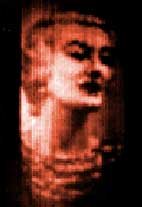TV 81 THIS YEAR
The medium of television marks a milestone in 2006: its 81st birthday.
Late in 1925, a failed Scottish inventor working alone in a tiny London attic apartment developed the first practical television system (read: it worked). Few recognize the name John Logie Baird, but he was the first to demonstrate a working television system - camera, transmitter, and receiver/display.
 Two years later he was making video recordings that can be viewed today.
Two years later he was making video recordings that can be viewed today.Television had been speculated about since the mid 1800’s, decades before actual motion pictures or radio. In 1886, one Paul Nipkow, who apparently did little follow up on his Nipkow Disk, patented this key element in Berlin. The disk was further developed into an accurate scanning device, so that facsimiles of documents (faxes) could be transmitted from city to city - hundreds per hour to Paris offices by 1900. In Wales, mug shots and sketches of suspects were being sent ‘wireless’ to remote police stations by 1912.
But the triple problem of capturing live movement (camera), sending that dynamic image electronically (transmitter), and reproducing that moving image (‘TV set’) had never quite been solved when Baird decided to tackle the problem.
Baird was an inventor with no formal training as a scientist, tech school rather than university educated. The research and development on his ‘Televisor’ was a solo job: no assistant, virtually no funding, no libratory, no support from the scientific or academic community and no affiliation with any institution.
He had a dubious track record as an experimenter. As head engineer at Glasgow, Scotland’s only power plant, he caused a blackout of the entire city when he sent a huge amount of electricity into a vat of wet cement. Instead of the diamonds he had attempted to synthesize, he got hot, wet cement - and a pink slip. Utilizing the mechanical scanning principle of the Nipkow Disk, Baird cobbled together a camera and receiver/display out of a hatbox, bike-lamp lenses, sealing wax, darning needles, neon lamps, light-sensitive selenium, and, for the unfortunate soul in front of the camera, unbearably bright hot lights.
In October of 2006, eighty-one years will have passed since the first crude images of a ventriloquist’s dummy head appeared on Baird’s two-inch ‘screen’. The reddish image was composed of only 30 lines (interlaced!) and moved at 12 1/2 frames (25 fields) per second. Like video on the web today: crude but recognizable.

Baird demonstrated his system to the Royal Academy of Sciences in the spring of 1926. One of the distinguished gentlemen of the Academy caught his beard in the spinning disk apparatus. Eager to market his idea, Baird had regular demonstrations of his system in London’s Selfridges’s department store by year’s end.
Baird negotiated with the BBC, then Britain’s only broadcaster, to lease their radio transmitter’s time after midnight to test television reception. (Yes, public-access fans: the first television broadcasts ever were a leased-access affair!) Later, the Beeb would use his system for their first (pre-1936) TV standard.
Between 1926 and 1933, Baird would invent practical, working systems of almost every video device we know and love today. Color, ‘high’(er)- definition, three-dimensional video, infrared video, video projection, videodisks, home videodisk recorders, film to video transfers: all were successfully developed, demonstrated - and even marketed - by Baird. A London theatre was projecting color video of live horse races broadcast from the provinces. Selfridges’s even sold Baird home videodisk recorders in the early 1930’s.
So: why have you never heard of this John Logie Baird, alleged inventor of the most profound and pervasive communication technology in the history of mankind? Baird, for all his accomplishments, relied on a mechanical - not electronic – TV system. The spinning disks and pulsing lights of the system limited the amount of resolution, or detail, that could be reproduced. As rival electronic systems improved in the mid 1930’s, Baird was forced to buy into competing technologies.
Before his death in 1946, Baird had adopted an electronic scanning system, and had filed patents for true high-definition television, scanning up to 1,700 lines vertical (today’s HDTV is a mere 1,125 lines).
Some of Baird’s accomplishments would not be duplicated for decades. Incredibly, his legacy includes real video recordings from as early as 1927. Actual restored video from these disks can be viewed online at www.tvdawn.com. A wiggly home video recording from 1933 is also on display.
Many names are mentioned as ‘the inventor of television’. John Logie Baird was the first to get a picture, and the first to realize television as a flexible, multipurpose medium.
(30-30-30)
© 2006 Richard Speziale All Rights Reserved


0 Comments:
Post a Comment
<< Home